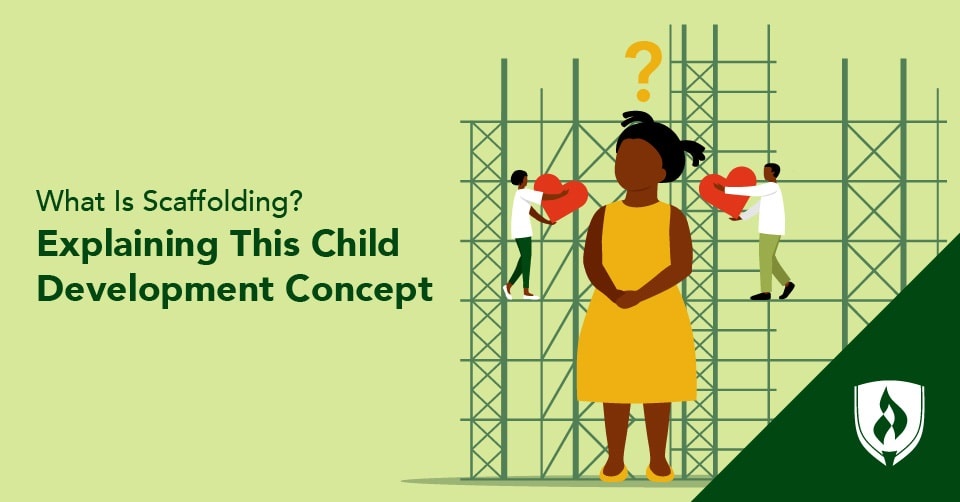
As adults, life has taught us how we learn best, and this allows us to catch onto new skills quickly. For some, we know that writing things down helps us to remember better. For others, we know to find visual examples to fully understand them.
Whether you are teaching students in your classroom or attempting to guide the kids around your kitchen table, it’s important to keep in mind that they don’t understand how they learn best just yet. It is the job of parents and educators to guide them—and that’s precisely what the concept of “scaffolding” refers to in child development. Social referencing, which involves children observing and imitating the reactions of others, plays a crucial role in this process. You can learn more about social referencing in child development here.
What is scaffolding in child development?
When you think of scaffolding, you probably picture a construction site. That’s not a bad reference for understanding the concept in early childhood education.
In construction, scaffolding is used to reach the next level of a building project. This temporary structure allows builders to take the necessary steps to complete the project. Without scaffolding, they would only be able to finish tasks at the ground level.
Scaffolding in child development is similar, though not quite so literal. This technique is defined by the use of demonstrations and intentional support offered by the instructor. Think of it as a temporary supportive structure, like construction scaffolding, that allows a child to learn large concepts in small chunks. The goal is to guide, uplift and provide boundaries for children as they learn and grow.
Common scaffolding techniques for educators
So what does scaffolding look like in practice? It can take a wide variety of forms, but there are some common tactics and approaches for guiding child development.
Scaffolding is a delicate tool. Whether you want to use scaffolding in your home to teach your child how to do simple tasks or are considering stepping into the ECE field, these scaffolding techniques will benefit your understanding of the framework and guide you as you plan.
1. Ask prompting questions
Providing prompts and encouraging students to come up with their own answers is a tried-and-true scaffolding approach. Keep in mind that it can be helpful to plan some of these questions ahead of time. This allows time for you to think through what you expect from the answers and to plot how you will guide students through a well-rounded discussion about the topic.
2. Make suggestions
Offer hints that point them to an answer without giving it away. This will help them to build up to the answers rather than feel pressured to know everything all at once. Again, it all comes back to giving them the information in manageable chunks—sort of like leaving a breadcrumb trail that shows your thought process.
3. Provide activities just above their ability
Your goal as the educator should be to stretch them without expecting complete understanding right away. Give them space to begin understanding the concept and then ask them to begin taking steps to prove that understanding.
4. Show and tell
Most of us remember standing in front of the classroom with our favorite toy explaining why that stuffed animal or toy monster truck was extra special. Using show and tell with scaffolding is the same concept but more in-depth.
Demonstrate something by modeling it and then explaining it. The illustration of a physical thing is a great way to lead into a verbal explanation. This works especially well for visual learners but is always a fun and engaging lesson for all.
5. Build off prior knowledge
Ask them about their experiences and ideas about a topic. When they can relate their life to their learning, the topic comes alive. Often, students find it easier to understand a concept if they can connect it to experiences that they have had.
Another great way to use experience as a tool for scaffolding is to provide them with moments that tie into learning.
Katelyn Rigg, founder of Literacy Learn®, recommends that educators “Provide authentic experiences and connect them to text. For example, take a day trip to a zoo and then read aloud books about zoos.”
6. Guided “think out loud” time
Guide them to think critically about problems or scenarios. When doing so, it is essential that scaffolding doesn’t become an excuse for reinforcing only surface-level learning. Instead, encourage in-depth learning through slow, easy steps while narrating your thinking.
7. Pre-teach vocab
It can be easy to lose sight of this, but new concepts or experiences come with new language. First, introduce terms with photos or by example. Second, ask the student to provide their own definition based off what they saw. Finally, move to dictionary definitions. This process limits the stress that comes with a long list of wordy definitions.
8. Adjust to the learning style of the child
Teaching to learning styles can make or break your lesson. If you lean too hard on visual learning, you will miss the other half of the classroom that learns kinesthetically and needs to touch the topic, not just see it. Knowing a child’s learning style is pivotal to being able to teach them well.
9. Encourage “thinking about thinking”
Allow them to verbally make sense of what they are learning. Make space for discussion focused solely on their thoughts about a topic. Ask questions and encourage them to ask their own.
This is a great way to encourage critical thinking and open discussion. Scaffolding is not just about test results; it’s about preparing students as they develop and equipping them with the skills they need to succeed—all without overwhelming them and making learning a chore.
The benefits of scaffolding in education
The ultimate goal of scaffolding is to see students learn and grow. Under that large umbrella goal, there are smaller things that benefit the students, the instructor and the entire learning atmosphere.
1. It’s flexible in format
Often in education, it is common for concepts to be taught one way to all students. This restricts students to one kind of learning, and for some, this makes comprehending information extremely difficult.
With scaffolding, the lesson can be fitted to the learning style of the student. For example, say a visual learner is struggling to comprehend a story. With scaffolding, the instructor could preview the text and offer visual examples of key vocabulary and concepts. This way, the child receives the text in pieces that make sense to them and that they can put together to understand the whole thing.
This is one of the greatest benefits of scaffolding. It leaves room for all types of students to learn the same thing in a way that makes sense to them.
2. It builds confidence
Scaffolding provides students with a structured set of steps to reach levels that once looked too challenging. Without the pressure to prove an almost immediate understanding of a topic, students are able to gradually grow in their understanding of a concept—and their confidence.
Due to the adjustable pace, scaffolding can help children move from feeling overwhelmed to self-assured. The classroom can become a safe space to process information and grow in new knowledge.
3. It encourages growth at all competence levels
The academic capabilities of children are not uniform. Scaffolding techniques focus less on uniformity in test results and more on providing an attainable path to individual growth.
Mary Gurley, director of curriculum at eSpark® Learning, says, “The most obvious, and possibly most important, benefit to scaffolding education is motivating students with an attainable education. Meeting students at their own unique level encourages them to grow at their own pace while providing the intervention they deserve.”
4. It helps identify gaps in understanding
We have all had moments of confusion where we are tasked with explaining something we didn’t fully understand.
Scaffolding seeks to erase confusion. It helps identify gaps between what a child knows and what they still have to learn. This requires a consistent assessment of progress.
Measuring progress in scaffolding is relatively simple. Take note of growth, in any amount. As the child learns, they should be able to explain or discuss a concept without guidance. As you do less, they do more.
Ingrid Moats, veteran math teacher and owner of Tampa Bay Test Prep, shared, “Scaffolding helps us to quickly bridge the gap from what they know now to what they need to know. It’s like taking a student up a mountain but stopping at each rest stop to assess their understanding.”
Scaffolding zeroes in on the students and considers how they’re receiving the information. It asks, “Are they understanding the whole concept or just pieces?”
The challenges of scaffolding
Despite the benefits, there are a handful of factors that have led educators to shy away from using this technique in their classrooms.
1. It requires significant planning time
Depending on the subject and circumstance, the up-front workload for using scaffolding techniques can be heavy.
A big part of that is planning for different learning styles. The educator needs to be able to teach hands-on learners and the by-the-book kids in the same classroom. Before you even enter the classroom, you need to have a firm grasp on the learning styles and an abundance of ideas for teaching each of them.
Choosing activities that can cater to different styles is time-consuming and complicated. It requires creativity and flexibility. This is true for parents and teachers. So, build up a backlog of ideas and keep them in your back pocket.
2. Understanding who you are teaching
As you lay out your lesson plans, it is important to identify the strengths and weaknesses of your pupils, and this can be difficult to nail down.
Apart from learning style, each child is equipped with unique strengths and areas they excel in. Some are drawn to words and languages, while others can take a random assortment of items and construct a device. Knowing where they are strong will help you to stretch the places they are weak.
As children grow, their strengths and weakness will develop and change. The educator needs to be sensitive to the unique personalities and skill sets of each child. Once understood, you can adjust lessons from there.
3. Knowing when to let go
As with construction scaffolding, a pivotal part of this process is the removal of the scaffolding. It’s a careful balance. If the scaffolding is left too long, it can cause a child to take steps backward, or it can become a sort of comfort zone as the child never learns to stand on their own. If it is not left long enough, the child will remain stuck, unable to see progress.
Do’s and don’ts of scaffolding
Using scaffolding techniques as an educator requires you to walk a fine line between providing support and becoming overbearing. Here are a few warnings and suggestions for educators new to the technique:
- Beware of hovering: Provide a guiding hand, not forced direction. You take a backseat to the students’ understanding. Remember, you are a supporting role, not the lead actor.
- Don’t over teach: Instead of lecturing, encourage conversation. Allow the child to show what they have learned as they go. Scaffolding is all about lifting them up so they can reach new levels. Once they have a grasp on the concept, let them begin teaching themselves.
- Prepare to let go: Your job is to instruct the student so that they can accomplish something without help. For them to succeed, you must take your hands off and let the child figure it out on their own.
Helping little ones grow stronger and smarter daily
Scaffolding is centered on growth and development. The work educators put in to support young children as they push them to new heights is substantial but ultimately rewarding. If you’re invested in the idea of building up our youngest learners and preparing the next generation for success, you may be a good fit as an early childhood educator. Check out our article “9 Signs You Should Be Teaching Preschool” for more insight into whether this field could be right for you.
Literacy Learn is a registered trademark of Literacy Learn LLC.
eSpark is a registered trademark of eSpark, Inc.




